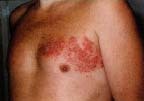Shingles
Shingles is caused by a viral infection of the sensory nerves of theskin and causes a painful rash on the skin. The medical name forshingles is "herpes zoster." The virus that causes herpes zoster is thesame virus that causes chickenpox (varicella).
KEYWORDS
for searching the Internet and other reference sources
Dermatology
Infectious diseases
Viruses
Zoster
What Is Shingles?
A person cannot develop shingles unless he or she has had chickenpox. Shingles is caused by the same virus that causes chickenpox, the herpes zoster virus. Whereas chickenpox is a highly contagious disease, shingles usually is not transmitted from one person to another. However, a person can develop chickenpox from coming in direct contact with the blisters on a person with shingles. After recovering from chickenpox, the herpes zoster virus may remain in part of the nervous system for years without causing any illness. Shingles may be brought on as a side effect of another disease, such as Hodgkin's disease (a cancer of the lymph system), or from treatments that suppress the immune system * . However, most of the time, there is no known cause for the virus to become active and cause shingles.
* immune system fights germs and other foreign substances that enter the body.
What Are the Symptoms of Shingles?
The affected skin area first feels sensitive, and then becomes painful. Before blisters from shingles develop, a person may have chills and fever, feel tired, and have an upset stomach. These symptoms may last for 3 or 4 days. By the fourth or fifth day, a rash made up of small red spots appears. The small red spots turn into blisters that are filled with the herpes zoster virus. After another few days, the blisters become yellow and dry out. Crusts develop over the dried-out blisters. When they drop off after several weeks, they sometimes leave small scars.
Usually, the rash and blisters involve a limited area of skin, most often on one side of the chest, abdomen, or face.

What Is the Treatment for Shingles?
Treatment for shingles is directed mainly at reducing the pain involved. Medications are also used to attack the viruses. Wet compresses applied to the affected areas can sometimes soothe the pain. Mild pain relievers such as acetaminophen can be used.
Who Is at Risk for Shingles?
Shingles occur mostly in older people whose immune systems are no longer able to keep the virus in the nervous system inactive. This age group develops shingles more often, although shingles can develop at any age. After an attack of shingles, a person may be immune for the rest of his or her life.
Most people recover from the disease without any problems. However, in older patients, the pain may last for months or years after the blisters have healed. This is called postherpetic neuralgia (post-her-PET-ik noo-RAL-je-ah).
What Other Diseases Can Herpes Zoster Cause?
The herpes zoster virus can cause several other diseases:
- Chickenpox is usually a mild disease that causes a rash and fever. It is very contagious.
- Herpes zoster oticus, also called Ramsay Hunt syndrome and viral neuronitis, causes ear pain, hearing loss, vertigo (a spinning sensation), and may paralyze a part of the face.
- Ophthalmic herpes zoster involves the eyelid and sometimes the eye itself It can be serious if the eye is involved.
See also
Chickenpox
Resources
Oldstone, Michael. Viruses, Plagues, and History. New York: Oxford University Press, 1998.
Schwarz, Richard H. "When You Get a Childhood Illness." American Baby, February 1999, p. 22.
The U.S. Centers for Disease Control and Prevention (CDC), 1600 Clifton
Road, N.E., Atlanta, GA 30333. The United States government authority
for information about infectious and other diseases, the CDC posts
information about shingles at its website.
http://cdc.gov/ncidod/srp/varicella.htm
Comment about this article, ask questions, or add new information about this topic: